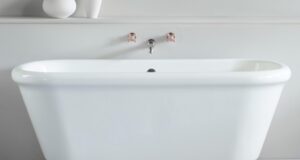
Most splashbacks can be cleaned with a damp cloth and a bit of household cleaner, but different types of materials will require different levels of care.

Most splashbacks don’t require a lot of care, but may be damaged if you don’t clean them properly.
Most splashbacks can be cleaned with a damp cloth and a bit of household cleaner, but different types of materials will require different levels of care. Here are a few tips to keep your splashback in pristine condition:
How to clean and maintain acrylic splashbacks:
- Clean your acrylic splashback with a damp cloth and an all-purpose cleaning agent.
- To avoid streaking, use a dry cloth after the wet one.
- Never use abrasive cloths or cleaning agents – acrylic in particular is fairly easily scratched, and won’t tolerate abrasion too well.
- If you do scratch your acrylic splashback, you may be able to buff it out. Contact the manufacturer for recommendations.
- Ensure that the edges of your acrylic splashback are properly sealed with a silicone sealant. If the silicon fails, repair it immediately.
How to clean and maintain stainless steel splashbacks:
- Stainless steel cleaners will work wonders on your stainless steel splashback.
- Remove splashes and spills as they happen. This will help to keep your splashback looking good, and reduce the need for heavy cleaning which may scuff your splashback.
How to clean and maintain glass splashbacks:
- Clean your glass splashback with a damp cloth and a glass cleaner.
- To avoid streaking, use a dry cloth after the wet one. Buffing with a piece of paper is a particularly effective trick when cleaning glass.
- Never use abrasive cloths or cleaning agents.
- Regular water checks are mandatory. Replace if the splashback has been compromised.
- Ensure that the edges of your acrylic splashback are properly sealed with a silicone sealant. If the silicon fails, repair it immediately.
How to clean and maintain tile splashbacks
- Clean tiles with a damp cloth and a household cleaner. Wipe them dry to prevent streaking.
- If you’re buying tiles, buy extra in case they crack or chip. This will help to ensure that you always have the exact right colour and style.
- Tiled splashbacks are resilient, however it is good practice to remove splashes and spills as they happen. This will reduce the risk of staining, and in particular will protect the grout between tiles.
- When you’re getting your tiles installed, remember to check the warranty on workmanship. If the grouting or adhesive fails, it’s likely because of poor workmanship.





